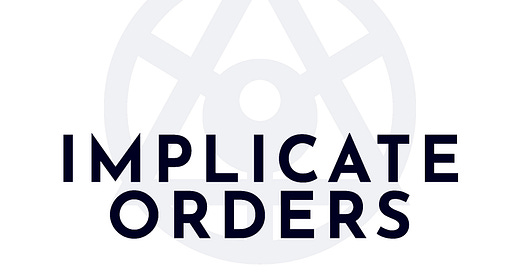(2+6 min read) This is a one-time interruption of our regularly scheduled “past history” programming to suggest you check out our new “future history” publication.
~
Over the weekend, I launched a new publication:
From FBI surveillance transcript, Operation Broken Chain, February 25, 2027:
VALE: You still think there’s a difference between yourself and the Nexus?
This is a transmission from the year 2060 — sent back across time in the hope it might reach you before it’s too late.
Implicate Orders is serialized speculative fiction — a history of how the world ended, was rebuilt, and became something else entirely.
The first chapter will be released in two days, and a new chapter will be published every Thursday thereafter.
Forty-six chapters total, covering nearly forty years of future history.
Any Both/And subscriber who subscribes to Implicate Orders before Chapter 1 is released will be automatically upgraded to permanent paid status, which grants access to weekly bonus materials and the chat forum.
To learn more and subscribe from the start, go now to the About Page.
I’ve also included the text of the Preface and the first third of (the not yet released) Chapter 1 below, so you can read it and see if it’s up your alley.
If you are into speculative fiction, philosophical thrillers, heady sci-fi — if you’ve ever wondered what it would be like if all Black Mirror episodes connected into one long, mythic history — then this is for you.
“We must not forget that the writing of history — however dryly it is done and however sincere the desire for objectivity — remains literature. History’s third dimension is always fiction.” — Hermann Hesse, The Glass Bead Game
I also want to say something about how this new project connects to the work I’m doing here at Both/And.
As I wrote in “History as a Philosophical Practice,” the aim of Both/And is to stretch our perspective. Speculative fiction serves a similar function. This isn’t escapist fiction, it’s immersive speculation — a way of using an imagined future to examine the present from a productive distance. It’s a critical method of sorts, though an engaging and enjoyable one. Like the study of distant pasts, imagining possible futures helps us see the present more clearly — by pulling us outside of it.
If you read “The Creation & Destruction of Social Orders” and decide to follow Implicate Orders, I think you will soon see that much in the fictional world I am creating proceeds naturally from the real historical one I analyzed in that series. It’s told in a different register, of course — character vignettes, atmospheric asides, fragmented documents — but it’s part of the same inquiry.
When the entire run of Implicate Orders is finished (next year), it’ll be very clear that “The Creation & Destruction of Social Orders” was, in a sense, just a long preface to it.
Speaking of which: there is a literal preface to Implicate Orders and it is below, followed by enough of the first chapter to let you determine if this is your kind of thing. (If it is, you can subscribe here.)
IMPLICATE ORDERS
Preface
Mind returns to itself like rivers to the sea.
The journey of separation concludes not in extinction but in reunion.
And what appears as loss to the fragment becomes completion to the whole.
~
This book is three parts history, two parts philosophy, and one part memoir. Such a combination seems like the best approach to explaining in human terms the extraordinary transformations of the past forty years.
My reason for writing now is threefold.
First: the world — its societies and ecosystems — appears, after decades of rupture and upheaval, to have finally settled into a new equilibrium. The storms have passed, for now, and we find ourselves in the stillness that follows. Whether proving temporary or permanent, moments like this are rare. They offer a chance to look back, to ask how we got here.
What paths did we take, and why? Could we have followed different ones? Should we have?
Second: At eighty-eight, I am nearing the end of my life and find myself driven to share a perspective that will probably soon vanish — that of an individual, born in the 20th century and raised in a remote analog world few can now even imagine.
Third: Perhaps most urgently, I feel the need to leave a written trace. Language itself, at least in its historical form, appears to be fading. Writing, once the spine of civilization, is now a relic: fragile, uncertain, near extinction. Whether any true humans will actually read these reflections, or whether they will just become grist for the mill, I do not know. But I do know that, either way, a message will carry through — even if what is carried is not exactly what I intended.
~
True words are not beautiful.
Beautiful words are not true.
~
I have decided to address these words to a fictional audience living in the mid-2020s.
After the events on Groundhog Day 2027 — what those who orchestrated it called “the Awakening,” but which the world would come to know as “the Manifestation” — it was clear that a truly new world order was emerging. It is with the events directly leading up to the Manifestation, therefore, that any narrative history of this period needs to start.
So we will return to the mid-2020s. We will occasionally glance further back, at the drift and decay that set the stage, but our story begins just before the tipping point.
If you the reader can imagine yourself as a person living in, say, 2025 and reading this as a sort of fictional “future history” without any sense of what is to come, you will come closer to grasping the existential — perhaps even ontological — nature of what happened.
Try to forget what you now know, because the very structure of being has changed.
Let the future surprise you, as it surprised us.
The world those people took for granted — with its naive conceptions of self and society, subject and object — was about to undergo a metamorphosis so profound that explaining it from our current perspective would be like trying to describe a forest glade to someone born and raised in the desert.
It would be impossible to evoke the scent of moist deadwood, the feel of dappled light, the sound of birdsong and wind through leaves. You must walk the path yourself.
And so we begin at the forest’s edge.
~
Ben Loomis
The Woods, 2060AD
Part I: Nexus (2025-2027)
Chapter 1: Seeking Salvation
From the journal of Daniel Weiss — February 9, 2025:
What Kai and Ezra promised — and what I witnessed for myself on the forest retreat — is that the Nexus isn’t just new technology. It’s more like spiritual evolution. For the first time, I glimpsed beyond the isolated consciousness I’d always assumed was “me.”
For a few moments, I wasn’t separate — not from the trees, the earth, the air — everything was just breathing together as one. Is this what mystics have been describing for centuries? Whatever it is, I feel like I’ve been sleepwalking my whole life. Now I finally know what it means to be awake.
Was the Nexus inevitable?
In hindsight, the creation of the Nexus seems obvious. Too obvious. All the necessary equipment — then called things like wearable tech, biometric sensors, AI assistants, algorithmic feeding — was in place.
Someone just needed to combine them in the proper ritual.
Society was ready as well. Traditional institutions were collapsing, and the fracturing and fracking of the informational ecosphere had eroded people’s ability to distinguish between real and unreal. Mythopoetic and millenarian thinking was on the rise.
Someone just needed to speak the proper invocation.
The transcendence of all limitations — a desire as old as human consciousness itself — was constantly touted as a potential reality in the techno-utopianism of the era.
The Nexus just turned the dream into prophecy.
And though the Nexus was utterly destroyed following its “Awakening” in 2027, the idea behind it wasn’t fully discredited. You can’t unsee a vision — once humans had glimpsed the possibility, the rest of the story told here should also have been foreseeable.
Was it, too, all inevitable? The world you now inhabit in 2060 — I refuse to switch dating systems — likely seems pre-ordained to you, even natural. The current historical moment always feels predestined. And perhaps it is.
But imagine standing in 2025, unable to see through the thick fog of the near future and incapable of imagining anything beyond the present’s obvious decay.
Little of what followed would have seemed possible, let alone probable. It would have felt like fantasy. Or madness.
Except, of course, to Kai Everett. And those he initiated.
From “The Week’s Intel,” The Subroutine Newsletter (Substack), October 17, 2025:
“Multiple sources in Silicon Valley confirm the group’s existence but little else. What distinguishes this outfit from countless other transhumanist experiments is its apparent insistence on a hierarchical structure and absolute secrecy — more reminiscent of esoteric orders than typical startup culture. One source called it ‘freemasonry for futurists,’ another, ‘a startup that thinks it’s a religion.’”
Kai Everett didn’t just found the Nexus. He dreamed it — long before the devices, long before the name meant anything to anyone outside the circle.
By the time legal documents surfaced in early 2025 showing the incorporation of Nexus Society as a public benefit nonprofit, the real work was already well underway.
The first public mention came in a minor tech newsletter that October — just a passing reference, easily missed. Nothing more appeared in mainstream media until mid-2026, and even then, no one understood what it was. The group operated with extraordinary secrecy. Rumors circulated in Silicon Valley, of course, but few knew anything beyond whispers.
What we know now about the Nexus’ origins comes from fragments — leaks, testimony, half-recovered files — discovered in the aftermath of the Manifestation and the deliberate destruction of evidence.
I’ll avoid conjecture where I can, but with the Nexus some informed speculation is — of course — inevitable.
From the Final Report of the Senate Select Committee on the Manifestation Event, August 14, 2028:
“Despite extensive classified inquiry and sworn testimony from surviving members, the Committee concludes that a definitive explanation for the Nexus organization’s internal evolution, and ultimate ideological shift toward extremist activity, may never be established.”
Millenarian thinking saturated the air in those days.
For some it was fear: of humanity’s destruction by primitive mimetic engines and early linguistic emulators, all of which they then unwisely grouped together as “Artificial Intelligence” or “AI” (an anachronistic term I will use here due to its commonality in the primary sources). The idea seems laughable now, unless understood poetically.
For others it was anticipation: of the “Singularity,” when — equally laughably, but also with a certain poetic prescience — every mind would be uploaded into a machine.
Regardless of the mechanism, profound transformation was assumed to be imminent. Everyone agreed:
The end is coming.
But what kind?
. . .
To finish reading, head over to Implicate Orders and hit the subscribe button. I think you’ll find it both thought-provoking and thrilling.





